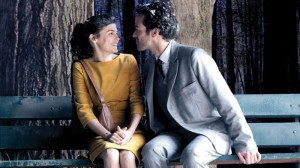About halfway through Mood Indigo, a film of inexhaustible creativity directed by Michel Gondry, the apartment that Colin (Romain Duris) and Chloé (Audrey Tautou) call home begins to change dramatically — the ceiling starts closing in, and a thick layer of cobweb starts covering the walls and windows. “My place is doing the same thing, but I think it’s an illusion,” says a friend when she drops in for a visit. “As you go through life, places seem smaller.”
The effect is an illusion in the cinematic sense, of course — one of many that Gondry brilliantly creates in this film using visual effects (stop motion, puppetry, scale models and plain old dress-up) that hearken back more to the birth of cinema and the Méliès brothers than to Transformers. But the illusion of shrinking rooms and changing worlds is also familiar to almost all of us from everyday life; it takes little more than a hangover, after all, for us to realize that physical spaces can appear to mutate according to our moods.
Gondry’s appreciation and insight into this phenomenon lends his special effects work more significance than mere playfulness. Adapted from a Boris Vian novel, Mood Indigo begins with the wealthy Colin discovering that both his best friend, Chick (Gad Elmaleh), and his chef/assistant/friend/lawyer, Nicolas (Omar Sy), have recently fallen in love. “I demand to fall in love, too,” Colin exclaims, and so he does, shortly after, when he meets Chloé, with whom he embarks on an idyllic love affair: Their first date takes place on a cloud-shaped saucer that gets lifted by a crane to give them panoramic views of Paris, where the film is set.
The cute factor of Gondry’s invented world at first threatens to overwhelm the movie, as does the sheer number of effects that he unleashes, which make the project appear like a mere excuse for him to show off his visual talents. That threat is only heightened by the fact that there’s little drama at first in the story. Chloé and Colin’s love suffers no hurdles as Colin’s wealth allows him to fix any problems that he or his friends might encounter. Everything is splendid, and the whole world, as Colin puts it later, “seems to smile.”

9(MDAxOTAwOTE4MDEyMTkxMDAzNjczZDljZA004))

